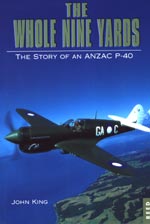|
|
|
|
| Missing In Action (MIA) | Prisoners Of War (POW) | Unexploded Ordnance (UXO) |
| Chronology | Locations | Aircraft | Ships | Submit Info | How You Can Help | Donate |
|
 by John King Reed Publishing 2002 Softcover 157 pages Photographs, index ISBN: 0-7900-0835-1 Cover Price: $25.00 Language: English
Also available via Return to |
The Whole Nine Yards The Story Of An ANZAC P-40 This book tells the story of Royal Australian Air Force (RAAF) P-40N A29-448: the history of the squadron and pilots who flew it, the story of its recovery and documentation of its restoration to flying status. Unique in its scope, this book is a must for Pacific War readers, as it connects the experiences of pilots who flew this specific P-40, and the complete story of the painstaking restoration process. RAAF No. 75 Squadron The book spans over a half century of history starting with the history of the Royal Australian Air Force (RAAF) No. 75 Squadron that flew the P-40 in combat in New Guinea. The history of that unit is introduced in the book's first chapter, detailing the precarious war situation that 75 squadron entered, even being fired on and damaged by Australian troops when they arrived at Port Moresby! This section includes airfield maps, and photographs, including never before published photographs from (former 75 squadron commander) Geoff Antherton's personal WWII photograph collection. 75 Squadron's pilots made history - and their namesakes were added to many famous airfields to honor pilots killed in action, including Jackson and Turnbill. The squadron's P-40's were the single line of defense for Port Moresby and Milne Bay in mid-1942. Later, the squadron followed US forces drive up the coast to bases including Nadzab, Hollandia and Nooemfoor. As the war progressed towards final victory, the role of Australian forces was regulated to mopping up pockets of Japanese resistance, while American planes and pilots got the glory of later operations. The Pilots & History of A Fighter Recovery In the mid-1960's , Darby began traveling to New Guinea, and photographed wartime aircraft wrecks for his 1979 book, Pacific Aircraft Wrecks. Also, the book mentions the trip to New Guinea to recover aircraft for American David Tallichet, a private warbird collector and founder of Yesterday's Air Force, today Military Aircraft Restoration Corporation. that recovered P-39s, A-20s and P-40s hulks at the abandoned Tadji airstrip, and pulled parts from other locations around New Guinea. Darby kept A29-448 as part of his agreement with Tallichet, and began working on its restoration. Fans of Darby's book will enjoy additional photographs from his collection used to illustrate this chapter, including a photograph of Tadji area villages holding an armful of money for parting with the aircraft on their land... in the early 1970's New Guinea was still not an independent country, and there were no laws to prevent recovery of what are today protected relics. Restoration Sections are devoted to a detailed history of the authentic Allison engine used, and a complete description of its wartime service, and accounting of every hour logged. Also, the origins of each of the P-40's 50 caliber machine guns, pulled from other wrecks around the Pacific and how contemporary aircraft components were integrated into the restoration, without compromising the historical accuracy of the aircraft, and shown with many photographs of the restoration process. An entire chapter is devoted to how the authentic color scheme of this P-40's WWII service with 75 squadron was achieve, and the difficulties in matching the colors. This exhaustive treatment of the restoration process, and arguable one of the best restorations of any WWII aircraft in the world, although the total financial cost is not mention, there was nearly a quarter century of work required to acquire and restore this warbird. Other Sections This book tells a complete story of one aircraft that flew in the Pacific during WWII, and the equally fascinating stories of the pilots who once flew it, and the personalities involved with its restoration. Interview with Charles Darby Review by Justin Taylan Return to Book Reviews | Add a review or submit for review |
| Discussion Forum | Daily Updates | Reviews | Museums | Interviews & Oral Histories |
|